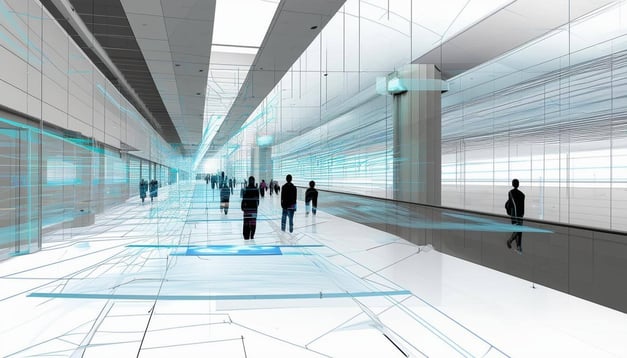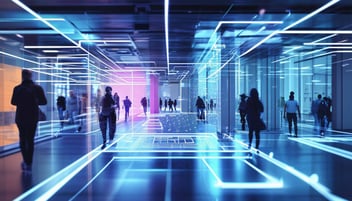< Back to the AR Wayfinding Guide
Fundamentals of AR Wayfinding for Indoor Navigation
Now emerging as a top contender for solving all manner of real-world problems, AR's most promising application may be wayfinding for indoor navigation. Whether in museums, industrial facilities, airports, hotels or malls, AR wayfinding offers a more interactive and dynamic alternative to traditional signage and maps.
This article explores the fundamentals of AR wayfinding for indoor navigation - how it works, the challenges it addresses, and its future.
- The Indoor Navigation Challenge
- How AR Wayfinding Works
- Why AR Wayfinding Matters
- Industry Applications
- What Businesses Should Consider
- The Future of AR Wayfinding
- Final Summary

The Indoor Navigation Challenge
Navigating indoor spaces has always been challenging. Unlike outdoor navigation, indoor navigation requires specialized technologies due to the inability of GPS signals to penetrate building structures accurately. Until now, large venues have relied on static maps or physical signs to guide people. While useful, these solutions can be confusing, especially in complex, crowded, or unfamiliar environments. Also, they're limited by physical constraints.
This is where AR wayfinding steps in, offering a more precise, editable, and interactive solution.
How AR Wayfinding Works
AR wayfinding overlays digital navigation instructions (and other media) onto the user’s physical environment. Using a smartphone, tablet, or AR glasses, users can view arrows, labels, or highlighted pathways that guide them to their destination. This immersive experience combines several technologies:
- Mapping Software: Floor plans and building layouts are digitized to generate accurate navigation paths.
- Indoor Positioning Systems (IPS): Bluetooth beacons, Wi-Fi triangulation, or LiDAR are used to pinpoint a user’s exact location indoors.
- AR Visualization Tools: Cameras and sensors capture the real-world environment, allowing AR elements to blend seamlessly with it.
The result is a navigation system that is intuitive and feature-rich. See more about the current state of technology in The 5 Best AR Wayfinding Technologies On The Market Right Now
Why AR Wayfinding Matters
Businesses are increasingly adopting AR wayfinding because it solves real problems and adds value for users and organizations alike. Key benefits include:
- Improved User Experience: AR makes navigation simple and engaging. For instance, shoppers in a mall can be guided directly to a store, while also discovering nearby sales or promotions along the way.
- Operational Efficiency: By reducing reliance on physical signs and customer service staff, businesses save time and resources. In a hospital, for example, AR wayfinding allows staff to focus on patient care instead of frequently assisting lost visitors.
- Accessibility: AR wayfinding can be customized for diverse user needs. Audio prompts can guide visually impaired users, and multi-language support ensures a more inclusive experience for international visitors.
- Data Insights: AR systems provide businesses with valuable analytics. Tracking user movement reveals traffic patterns, helping to optimize layouts, improve asset placement, or develop targeted marketing campaigns. See also: 5 Steps to Maximize the Benefits of AR Wayfinding After Deployment.
Industry Applications
AR wayfinding is already making an impact across various sectors:
- Retail: Large shopping centers can use AR to encourage customers towards promotions or amenities, enhancing their experience and longer visits (Capitalize on Custom: Benefits of AR Wayfinding for Malls).
- Healthcare: Hospitals and clinics can ease stress for patients and visitors by providing clear directions to specific departments or facilities.
- Airports: Navigating terminals can be overwhelming. AR wayfinding can help travelers quickly locate gates, baggage claims, or lounges, improving their journey (Optimize Operations: Benefits of AR Wayfinding for Airports).
- Corporate Campuses: AR tools can assist new hires, visitors, or even seasoned employees in navigating large office spaces, finding meeting rooms, or identifying amenities.
- Museums: Enriching visits beyond what physical limitations allow means that museums using AR Wayfinding will soon outclass those who don't (Making It Memorable: Benefits of AR Wayfinding For Museums).
- Event Venues: At conferences or trade shows, AR can help attendees locate booths, sessions, or networking areas, streamlining their experience.
What Businesses Should Consider
Implementing AR wayfinding requires careful planning. Here are some factors businesses need to keep in mind:
- Accurate Digital Mapping
High-quality maps of the indoor space are crucial for AR to work effectively. Maps should be regularly updated to reflect any changes in layout. - Ease of Use
The AR interface should be intuitive and visually clear. Overcomplicating the design can frustrate users rather than help them. - Scalability & Adaptability
The solution should be flexible enough to accommodate future expansions or changes to the facility. - Cost vs. Return on Investment
While initial implementation can be expensive, AR wayfinding often pays for itself over time by improving user satisfaction, reducing operational costs, and offering actionable insights. - Integration with Existing Systems
For businesses that already use mobile apps, integrating AR wayfinding can enhance functionality without requiring users to download a separate platform.
See also: Crucial Considerations Before Implementing AR Wayfinding
The Future of AR Wayfinding
As AR technology continues to advance, the potential for AR wayfinding will only grow. Several trends are worth watching:
- XR Glasses: While smartphones and tablets dominate today’s market, XR glasses are poised to provide even more immersive navigation experiences.
- AI-Driven Personalization: Artificial intelligence could make navigation smarter by tailoring routes to individual preferences, learning from its users, and even employing emotional intelligence (The 5 AI Features That Could Shape The Future Of AR Wayfinding).
- Smart City Integration: In the future, AR wayfinding will likely integrate with outdoor navigation systems for a seamless experience across entire cities - thus making AR Wayfinding a must-have for any venue.
See also: The 5 Most Exciting AR Wayfinding Technologies Now In Development.
Final Summary
By adopting AR wayfinding, businesses can differentiate themselves, meet the growing expectations of tech-savvy consumers, and gain valuable insights to drive better decision-making.
As this technology matures, the question isn’t whether AR wayfinding will become a standard—it’s how soon your organization can harness its potential.
Unsure which type of AR Wayfinding is best for you? Take our quiz.
Updated on January 8, 2025
by Joshua Simpson


